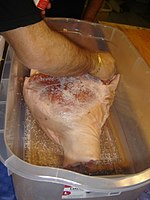
Photo from wikipedia
Low water activity (aW) foods permit the survival of low-infectious dose pathogens including Escherichia coli and Salmonella. Desiccation of non-heat resistant E. coli and Salmonella enterica increases their heat resistance;… Click to show full abstract
Low water activity (aW) foods permit the survival of low-infectious dose pathogens including Escherichia coli and Salmonella. Desiccation of non-heat resistant E. coli and Salmonella enterica increases their heat resistance; therefore, alternative methods are necessary to ensure the safety of low aW foods. High-pressure carbon dioxide (HPCD) reduced microbial contaminants in high aW foods. This study aimed to identify HPCD conditions that reduce pathogenic E. coli and Salmonella in low aW conditions. Four strains of Shiga toxin-producing E. coli (STEC) and one strain of enteropathogenic E. coli were treated as a cocktail, and five strains of Salmonella were treated individually. The suitability of E. coli AW1.7, Pediococcus acidilactici FUA 3072, Enterococcus faecium NRRL B-2354 and Staphylococcus carnosus R6 FUA 2133 as surrogate organisms was evaluated. Treatments were validated in beef jerky. Samples were equilibrated to aW 0.75 and treated with heat, HPCD or pressurized N2. Treatment of desiccated E. coli AW1.7 and the STEC cocktail with dry gaseous CO2 (5.7 MPa and 65 °C) did not reduce cell counts; however, treatment with gaseous CO2 saturated with water reduced cell counts of all strains of E. coli. Treatment of beef jerky inoculated with E. coli and Salmonella with saturated gaseous CO2 resulted in >5-log reductions for all strains. E. faecium NRRL B-2354 and S. carnosus R6 were suitable surrogates for Salmonella on beef jerky treated with HPCD. Treatment of beef jerky with water-saturated gaseous CO2 was more effective than treatment with supercritical CO2 or treatments with N2 at the same temperature and pressure. Overall, the treatment of low aW foods with water-saturated gaseous HPCD can meet industry standards by achieving a >5-log reductions of E. coli and Salmonella. Additionally, surrogate organisms representing pathogenic E. coli and Salmonella have been validated.
Journal Title: International journal of food microbiology
Year Published: 2020
Link to full text (if available)
Share on Social Media: Sign Up to like & get
recommendations!